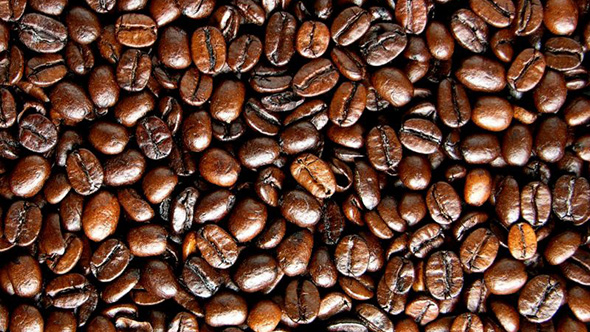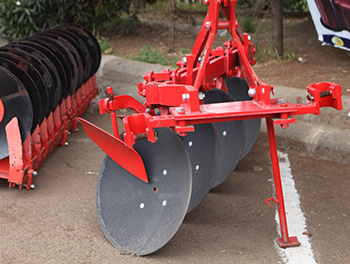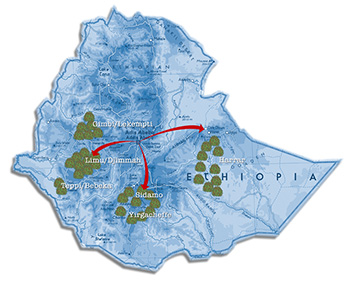Ethiopia’s agriculture: Analysis of agriculture production and its trends in Ethiopia
Ethiopia Sector Analysis
Ethiopia’s agriculture: Analysis of agriculture production and its trends in Ethiopia
In Ethiopia, where over 82% of the total population lives in rural areas, agriculture is the major means of earning a living. Taking about 43% of the country’s overall GDP, agriculture has been leading Ethiopian economy for years.

Ethiopia’s agriculture in 2014: Analysis of agriculture production and its trends in Ethiopia
By Bewket Abebe
ADDIS ABABA – In Ethiopia, where over 82% of the total population lives in rural areas, agriculture is the major means of earning a living and it constitutes the backbone of the economy. Taking about 43% of the country’s overall GDP, agriculture has been leading Ethiopian economy for years. Over 80% of the country’s exports comes from agriculture. The sector has traditionally represented a major source of the employment although recently the services and manufacturing (especially small and medium size industries) are taking over.

Land is considered to be the most precious asset within the community. The students’ movement that later led to 1974 revolution also used a slogan ‘Land to the tiller!’.
But given that agriculture productivity is dependent on rain fall, the sector has been highly vulnerable to crises that follow seasons falling short of rain. Whenever there is a shortage of rainfall, there is drought. Whenever there is drought, there is hunger; it is a cause-effect relationship. The country used to be exposed to serious food insecurity following different periods of drought.
Agriculture continues to represent one of the most promising sectors of Ethiopian economy. Out of the total of landscape of 1.4 million square kilometers, over 513 million hectares is the arable land. The country’s suitable climate is another advantage.
Export commodities: coffee!
Though the country has a clear aim to transfer itself into an industry-led economy, the role of agriculture is still highly valued. After all, such aim is a long-term one and cannot be achieved within a decade. Ethiopia’s export commodities are dominated by coffee. “Ethiopian coffee is organic and of excellent quality. We sell our coffee at a better price. We expect a better price from the buyers because our coffee is organic and special,” says Habtamu Silla, general manager of Aleta Land Coffee, which has been operating in Ethiopia for the last 14 years. Taking the coffee’s uniqueness into account, different governments of the country have been trying to devote a lot to increase agricultural productivity of Ethiopia by drafting packages.
The Ministry of Agriculture announced for the 2013/2014 fiscal year that 253.8 million quintals of crops are to be produced from the current harvest season, which is an increase of 22.5 million quintals.
The military socialist Dergue regime had framed a policy that aimed at expanding large scale farms. The administration, which also claimed that it would ‘put nature under its control’, wasn’t successful in ensuring food security in Ethiopia and a disastrous famine ensued.
The current administration is working hard on increasing the agricultural productivity of the country, thereby preventing food insecurity. Its Growth and Transformation Plan (GTP) aspires to increase the agricultural output by 8.4% per annum. The output has been steadily increasing during the past three years (about 7%) following the introduction of a new agriculture policy (e.g. it was 2.1% in between 1965 and 1973). The Ministry of Agriculture announced for the 2013/2014 fiscal year that 253.8 million quintals of crops are to be produced from the current harvest season, which is a 22.5 million quintals increase if compared to the last year’s harvest. “In the last few years, our agricultural sector has been growing quickly. In the last two years we have acquired a number of state farms and their output, in some instances, doubled,” witnesses Jemal Ahmed, chairman of Horizon Company, which belongs under MIDROC Group, the largest investor in the Ethiopia.
In order to prevent food insecurity in the country, the GTP for agriculture foresees 245 million quintals for base case scenario and 277 million quintals for high case scenario, which requires 8% growth during the five GTP years.

Difficulties of small-scale farmers
One of the factors that directly affect the growth of the sector are problems related to the difficulties that small-scale farmers experience when introducing and adapting to new farming techniques. In this regard, the government has deployed agricultural experts who are to work closely with the farmers and assist them.
Many small-scale farmers have become indebted following the expensive purchases of fertilizers, seeds and pesticides. The government is in this regard encouraging the farmers to use natural fertilizers which are first of all very availble.
Private companies eye to generate more profit from the sector. “We still don’t get the prices that we would wish for, but we are working on getting a better price. We need to add value to our export coffee, and that is part of our future plan,” explains Silla.
Attracting investments in the commercial farming is another area of interest for the government. “The metals, industry, energy as well as the pharmaceutical industry are all open to investment. However I think the most attractive sector is the agribusiness sector,” comments Getachew Regassa, secretary general of the Addis Ababa Chamber of Commerce & Sectoral Associations (AACCSA). The commercial farming is not living up to its potential—only 10% of the allocated land is actually being used for commercial farming purposes.
FAIR USE POLICY
This material (including media content) may not be published, broadcasted, rewritten, or redistributed. However, linking directly to the page (including the source, i.e. Marcopolis.net) is permitted and encouraged.